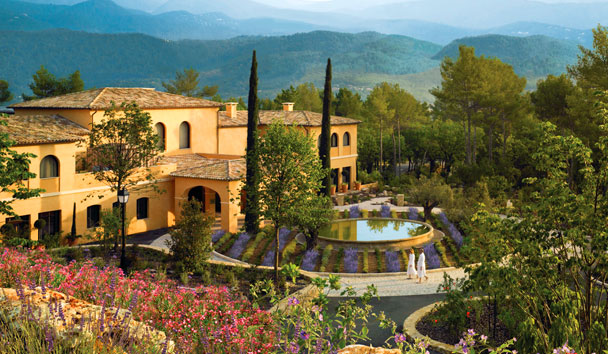
Four Seasons Resort Provence at Terre Blanche
Provence. A magical precinct made all-too-famous by Peter Mayle’s books, yet still the essence of the south of France. I was last there on a beautiful September day several years ago, but the best time to go is spring, when the land yields rich scents of rosemary, thyme and wild lavender, with a hint of cypress and pine. All you have to do is breathe.
Into this ancient fragrant realm, a software tycoon and avid golfer—SAP’s Dietmar Hopp—built a 36-hole resort complex near the villages of Fayence and Tourrettes about an hour’s drive from the Nice-Cote d’Azur Airport. Called the Four Seasons Resort Provence at Terre Blanche, the low-rise complex, tucked in the limestone-studded hills of the Alpes-Maritimes, had just opened when I visited in 2004.
I have two memories of being there. One, the sight from the hotel terrace of tiny medieval villages encircling the tops of broom-covered hills, unchanged for centuries. And two, the sight of Jean van de Velde, the fallen angel of French golf, sprawled like a puckish wayfarer on a lobby sofa in a T-shirt, cargo shorts and sneakers. No socks. I often wonder how different golf in France would look today had Jean found a way to win that crazy haunted Open at Carnoustie in 1999. At least for a short time, he would have been hailed as a national hero. And more attention would have been paid to the roughly 500 golf courses spread across the most under-appreciated golf destination on the Continent.
Having found a secluded site well inland from the sea, Hopp hired Englishman Dave Thomas to design two courses at Terre Blanche. Le Chateau, championship-caliber at 7,235 yards, is a solid parkland test dropped into a valley and cut through a mixed hardwood forest. Thomas, a former tour pro, built a course that would appeal to his lodge brothers—no hidden tricks and everything in plain view, from the gurgling rock-lined creeks to the numerous grass-faced bunkers. The most distinctive hole is the par-five sixth, notable for its hairpin-shaped fairway indented by a lake and for the 19th-century chateau that sits high above the green. (The edifice, reputedly built by Napolean for one of his generals, once belonged to Sean Connery).
The resort’s second course, Le Riou, occupies the site’s upper valley high above the region’s olive groves, its shorter, narrower holes carved from heavily wooded hills. Not long on the card at 6,567 yards from the tips, but strategy and precision are required to negotiate the layout’s ski slope drops, sharply angled fairways and multi-tiered greens. Le Chateau is a sober test for pros; Le Riou is a sporty romp for amateurs.
Both courses at Terre Blanche are extremely well-conditioned. At their center is a beautiful clubhouse done up in contemporary Provencal style. Les Caroubiers de Terre Blanche, a restaurant and bar with outdoor terraces, overlooks Le Riou’s water-guarded 18th hole. Deluxe locker rooms and a high-fashion golf shop are complemented by a practice facility and golf academy that have grown to outsize proportions since my visit.

The resort's Le Chateau course occupies a lovely valley.
Last year, the resort opened its Terre Blanche Albatross Golf Performance Centre, an integrated training facility designed to enable all golfers, hackers and experts alike, to train and improve in optimal conditions. Personally, I’m fine with a small bucket of balls and 15 minutes on the practice putting green, but true enthusiasts and grail seekers can take advantage of ultramodern analytical tools and state-of-the-art technological equipment to get to the bottom of things. There’s also a David Leadbetter Academy oat the club as well as BIOMECASWING, a center that combines biomechanics with modern technology to help players improve based their morphology and personal ability.
The finest year-round golf facility in Europe? Terre Blanche can make a case.
The Four Seasons Resort’s 114 suites, housed in a series of one- and two-story villas terraced into a hillside, are connected by meandering walkways landscaped with flowering shrubs. Enchanting views from their balconies and terraces look across the valley to the distant mountains and hilltop villages. While rather plain on the outside, the room interiors, their color palettes inspired by sunshine and flowers, offer a stylish, contemporary interpretation of Provence.
The spa, contained within a large ochre villa set high on a tree-shaded hill, is a genuine escape from the everyday world. Its specialty is an age-defying facial developed by Megan Larsen, founder of the Sodashi skin care company, but all of the treatments are excellent.
The resort’s main dining room, Faventia (“Fayence” in Latin), serves eclectic Mediterranean cuisine with a Provencal twist. It’s a Michelin 2-star restaurant. The cuisine is sublime, but for me, my thirst and appetite were quenched by the radiance of Provence and the two courses at Terre Blanche.
Details: http://www.fourseasons.com/provence/
